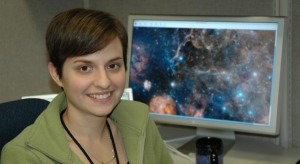Dec
29
A Puzzling Question Gets an Innovative Answer
December 29, 2008 | Leave a Comment
Ali Vanderveld, a post-doctoral cosmologist at the Jet Propulsion Lab and her colleagues recently published a paper in the journal Physical Review looking at how giant holes in our “Swiss-cheese-like” universe might make space look as if it’s accelerating when it’s really not.
Whew, I have been waiting for something to make more sense than the accelerating universe idea so popular of late. Vanderveld concludes these holes, or voids are not sufficient to explain away dark energy; nevertheless, she says it’s important to continue to question fundamental traits of the very space we live in. I should say so, as it’s been 10 years now that the “universe is accelerating at increasing speeds” idea got traction. It was an interesting idea, sort of a stretching of time and space, with lots of ideas on how this phenomenon works – so the invention of “Dark Energy.”
Vanderveld says, “Sometimes we take dark energy for granted. But there are other theories that could explain why the universe appears to be moving apart at faster and faster speeds.”
Now it’s granted that a large part of the universe is accelerating evidence comes from observations taken over the last decade or so of very distant, colossal star explosions called supernovae. The JPL’s own Wide-Field and Planetary Camera 2 on the Hubble Space Telescope contributed to this groundbreaking research. Astronomers had already figured out that space, since its inception about 13.7 billion years ago in a tremendous “Big Bang” explosion, is expanding. But they didn’t know if this expansion was happening at a constant rate, and even speculated that it could be slowing down. By examining distant supernovae billions of light-years away, scientists could get a look at how the expansion of space behaves over time.
The results were baffling. The more distant supernovae were dimmer than predicted, which would suggest they are farther away than previously believed. If they are farther away, then this means the space between the supernovae and us is expanding at ever-increasing speeds. Additional research has since pointed to an accelerating universe.
Researchers from Fermi National Accelerator Laboratory recently proposed what’s called the Swiss-cheese model of the universe to explain why these supernovae might appear to be moving faster away from us than they really are. The universe is made up of lumps of matter interspersed with giant holes, or voids, somewhat like Swiss cheese. Then last year, astronomers at the University of Minnesota reported finding the king of all known voids, spanning one billion light-years. The researchers at Fermi said these voids might lie between us and the supernovae being observed, acting like concave lenses to make the objects appear dimmer and farther than they really are. If that’s so, then the supernova might not be accelerating away from us after all. Their theory claimed to provide a way in which dark energy might go up in a poof of smoke.
So Vanderveld and her colleagues at Cornell University, Ithaca, N.Y., looked more closely at this theory and found a few “holes.” The group at Fermi had assumed a bunch of voids would line up between the supernovae, and us but Vanderveld’s group said, in reality, the voids would be distributed more randomly — again like Swiss cheese. With this random distribution, the voids are not enough to explain away dark energy.
“The lumpiness of the universe could still be tricking us into thinking it’s accelerating,” said Vanderveld. “But we did not find this to be the case with our best, current models of the universe.”
There remains one other freakish possibility that could mean a void is creating the illusion of an accelerating universe. If our solar system just happened to sit in the middle of a void, then that void would distort our observations. Vanderveld says, “It’s really hard to tell if we’re in a void, but for the most part this possibility has been ruled out.”
Dark Energy and Dark Matter are both troubling inventions to keep theory working. It’s been a decade that seems to me to be lost chasing an illusion. Better to ask what it is about our measuring that creates these circumstances and only when the measuring is sound start working on theory.
Vanderveld is quite right and it merits repeating – it’s important to continue to question fundamental traits of the very space we live in.


